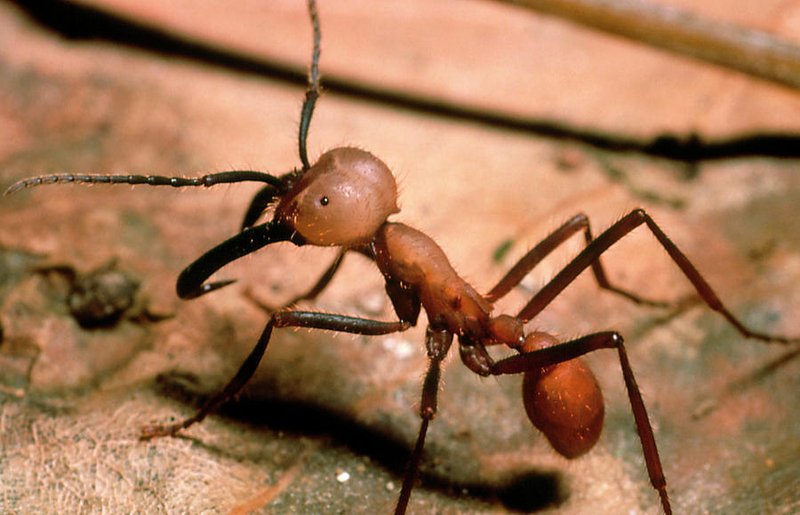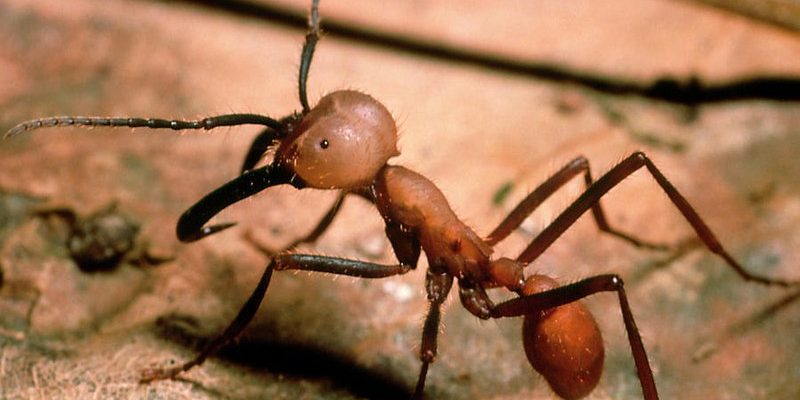
Imagine a tiny, yet fearsome army marching through the jungle, all with one goal: to hunt and gather food. This is essentially the life of an Army Ant. These ants belong to the subfamily Ecitoninae, and are best known for their aggressive foraging behavior and their large, nomadic colonies. Unlike many other ant species that build permanent nests, army ants are constantly on the move, creating temporary camps as they search for food.
Army ants primarily rely on their sheer numbers to overpower prey, which can range from insects to small vertebrates. Their colonies can number in the millions, and together, they can create a formidable force. It’s fascinating how these tiny creatures operate with such coordination and precision. Think of them as nature’s own little soldiers, always prepared for the next big hunt!
Let’s dive into what makes these creatures so extraordinary— from their social structure to their amazing hunting tactics. By the end of this journey, you’ll understand why the army ant is often the star of the jungle floor!
The Social Structure of Army Ants
Army ants live in colonies that can include hundreds of thousands to millions of individual ants. Within these colonies, there’s a complex social structure that governs their behavior. Like a well-oiled machine, each ant has a specific role, whether it be foraging for food, caring for the young, or defending the nest.
The queen, typically the largest ant in the colony, is solely responsible for reproduction. She can lay thousands of eggs daily, ensuring the colony continues to thrive. The workers are the backbone of the colony. This includes scouts who search for food, soldiers who protect the nest, and caretakers who tend to the brood. Each type of ant plays an essential role that keeps the colony functioning smoothly.
The interactions within the colony are also fascinating. They communicate through pheromones, releasing chemicals that signal danger or food sources. This chemical language allows them to coordinate their activities effectively, whether they’re setting out on a raid or responding to threats. It’s like having a high-tech system of messaging— all in the world of tiny insects!
Habitat and Distribution
Army ants thrive primarily in tropical and subtropical regions around the world. They are commonly found in the dense rainforests of Central and South America, as well as parts of Africa and Asia. These lush environments provide the perfect backdrop for their hunting lifestyle, rich in both flora and fauna.
What’s intriguing is how their habitat affects their behavior. The thick foliage of the rainforest offers cover as they navigate their surroundings. Army ants tend to adapt their foraging patterns based on the availability of food in their immediate area. If a certain route is plentiful in prey, you can bet they’ll stick to it until the food runs dry.
Interestingly, army ants do not make permanent nests. Instead, they create temporary bivouacs—structures formed by the ants themselves—using their bodies to form a protective barrier around the queen and larvae. When it’s time to move, they simply pack up and march on to their next destination. This nomadic lifestyle is what makes army ants stand out among their ant relatives!
Foraging Behavior
The foraging behavior of army ants is nothing short of spectacular. When it’s time to hunt, they set out in large groups, sometimes with up to 200,000 ants participating in a single raid. They make their way through the forest, searching for insects and other small prey to overwhelm. Think of them as a well-coordinated swarm, moving like a river of tiny soldiers.
What’s more impressive is their use of their environment to their advantage. They will often take the shortest paths to prey, using pheromones to communicate with one another about the best routes. This is where their collective intelligence shines. By working together, these ants can locate and capture food much faster than they could alone.
Their foraging raids can last several hours to days, and they can travel great distances in search of food. When they encounter prey, they use their powerful jaws to immobilize it, quickly bringing it back to their temporary nest. This method of hunting not only secures food but also showcases the incredible teamwork these ants exhibit.
Defense Mechanisms
While army ants are well-known for their ferocity while foraging, they also have impressive defense mechanisms to protect their colony. When threatened, soldier ants use their larger mandibles to defend against predators such as birds, mammals, or even other insects. They can fight off intruders with a fierce tenacity that showcases their commitment to the colony.
These soldier ants are not just massive; they also have a strategic advantage. Their ability to communicate through pheromones allows them to coordinate defensive efforts quickly. If one soldier senses danger, they can release a chemical signal that alerts others to prepare for a potential attack.
Another fascinating aspect of their defense is how they can quickly form a ball to protect the queen and larvae during an emergency. This behavior is akin to a living shield, ensuring that while individual ants may fall victim to predators, the colony’s heart remains safe. It’s a selfless act, showcasing how the survival of the colony outweighs individual survival.
Life Cycle of Army Ants
Understanding the life cycle of army ants is crucial to appreciating their role in the ecosystem. Their life begins when the queen lays eggs, which develop into larvae and then pupae before emerging as adult ants. The entire process can vary in length depending on environmental conditions but typically takes several weeks.
You might be wondering about the roles these ants will take once they mature. When army ants hatch, they are initially care for by the worker ants. Once they reach adulthood, they will take on roles based on the immediate needs of the colony. Some will become foragers, while others may serve as soldiers or caretakers. This fluidity in roles allows the colony to adapt rapidly to changing circumstances.
Interestingly, the queen has the ability to control the development of her offspring, choosing to produce more workers when she needs them or more soldiers when defense is paramount. This flexibility is essential to maintaining the colony’s strength and vitality. The life cycle of army ants is not just about growth but is intricately tied to the survival strategies of the colony.
Ecological Impact
Army ants play a significant role in their ecosystems. As formidable predators, they help control the populations of other insects, keeping the balance of nature intact. A colony of army ants can consume a vast number of prey daily, ensuring that the ecosystem around them remains healthy and vibrant.
Their foraging behaviors also contribute to the decomposition process in their environment. As they hunt, they disturb the leaf litter, breaking down organic material that serves as nutrients for plants and other organisms. In this way, they are integral to maintaining the health of their habitat.
Moreover, army ants’ presence attracts other species, including birds and other insects, that rely on them for food. This interconnected web of life demonstrates how these tiny creatures, through their predatory nature and social behaviors, help sustain a diverse range of wildlife.
Interesting Facts About Army Ants
| Species: | Eciton burchellii, Eciton hamatum, among others. |
| Size: | Approximately 8 – 12 mm long. |
| Habitat: | Tropical rainforests and subtropical areas. |
| Diet: | Primarily insects and small vertebrates. |
| Speed: | Can move up to 1 meter per second when foraging. |
| Lifespan: | Workers live about 1-3 years, while queens can live up to 10 years. |
Conservation Status
The conservation status of army ants varies depending on the specific species and their habitat. While many species thrive in the wild, habitat loss due to deforestation and human activities poses a significant threat to their populations. The destruction of tropical rainforests impacts the biodiversity these ants rely on for their survival.
Interestingly, army ants are considered indicator species. This means that their health and numbers can reflect the overall health of their ecosystem. When army ants are thriving, it typically indicates a well-balanced environment. However, if their populations start to decline, it can signal larger ecological problems.
Conservation efforts focused on protecting rainforest habitats are crucial for the survival of army ants and many other species that share their environment. By promoting sustainable practices and preserving natural habitats, we can help ensure that these fascinating creatures continue to thrive for future generations.
FAQ
What do army ants eat?
Army ants primarily feed on other insects, including termites and caterpillars, but they can also consume small vertebrates when the opportunity arises. Their foraging raids can lead to large-scale hunts where they overwhelm their prey using sheer numbers.
How do army ants communicate?
Army ants communicate primarily through pheromones, which are chemical signals that convey information about food sources and danger. This allows them to coordinate their activities effectively, whether they are foraging or defending the colony.
Why are they called army ants?
The name “army ant” comes from their highly organized and disciplined hunting behavior, which resembles a military operation. Their raids involve thousands of ants working together to search for and capture prey, making them formidable predators in the insect world.
Do army ants have a queen?
Yes, army ant colonies typically have one queen who is responsible for laying all the eggs in the colony. The queen is crucial for the colony’s survival, as she can produce thousands of eggs, ensuring the colony continues to thrive.
How long do army ants live?
Worker army ants usually have a lifespan of about 1 to 3 years, while the queen can live significantly longer, up to 10 years. The lifespan can vary based on environmental conditions and the specific species of army ant.
Are army ants dangerous to humans?
Generally, army ants are not a threat to humans. They don’t seek out people and will usually only defend themselves if their colony is threatened. However, their powerful jaws can cause painful bites if provoked.
How do army ants build their bivouacs?
Army ants build bivouacs using their own bodies to form a protective structure around the queen and larvae. They link together to create walls and ceilings, ensuring safety while they rest and reproduce. This behavior is unique and showcases their teamwork within the colony.
What is the role of soldier ants?
Soldier ants are tasked with defending the colony against threats. They are typically larger than worker ants and have powerful mandibles that allow them to protect their queen and brood from predators. Their role is crucial for the survival of the colony.
Can army ants change their roles within the colony?
Yes, army ants can adapt their roles based on the immediate needs of the colony. For example, a worker ant may transition to a soldier if the colony is under threat, showcasing their flexibility in maintaining the colony’s wellbeing.
What is a raid in army ants?
A raid is when army ants leave their bivouac in large numbers to forage for food. These raids can involve thousands of ants working together to locate and capture prey. They are known for their efficiency and coordination during these hunts.
How do army ants contribute to their ecosystem?
Army ants play a vital role in regulating insect populations and helping with the decomposition of organic material. Their hunting and foraging behaviors aid in maintaining a balance within their ecosystem, promoting biodiversity and healthy environments.
Are there different species of army ants?
Yes, there are several species of army ants, with Eciton burchellii and Eciton hamatum being among the most well-known. Each species may have slightly different behaviors and ecological impacts, but they all share the characteristics that make army ants unique.

